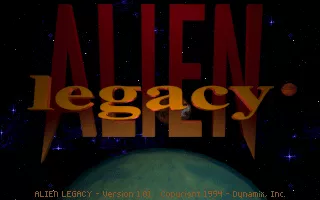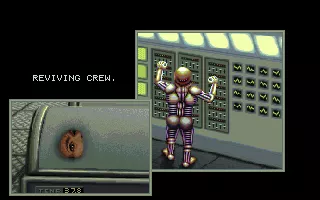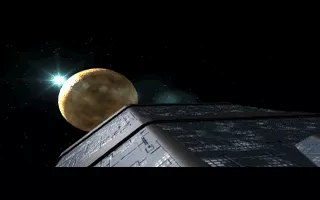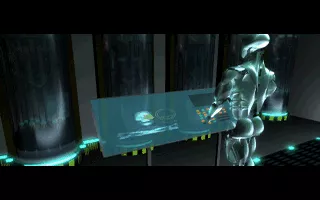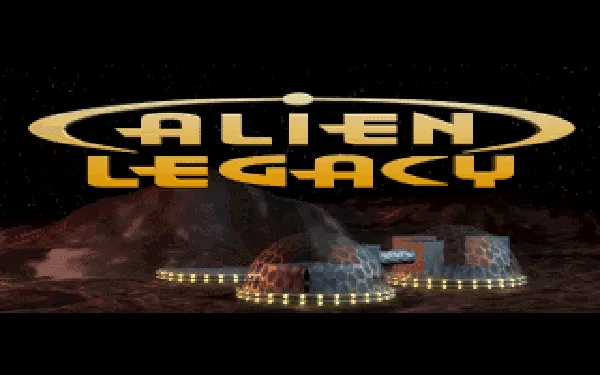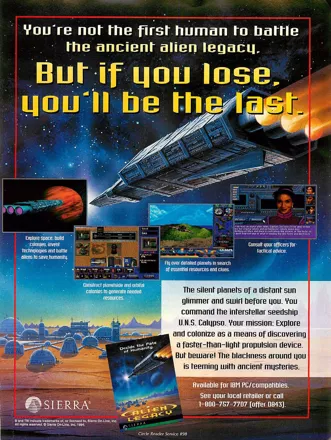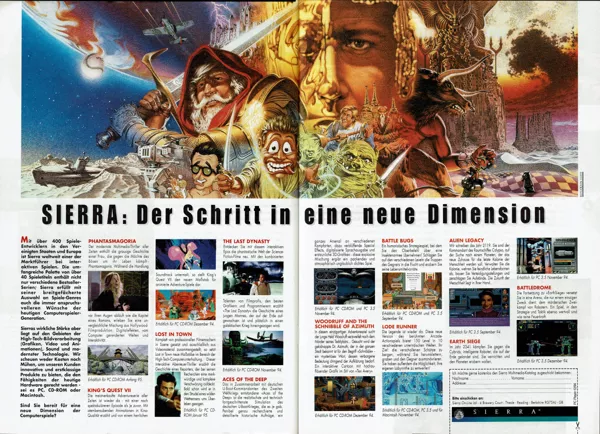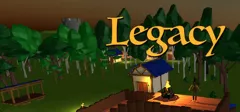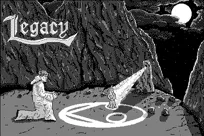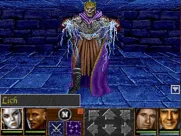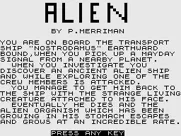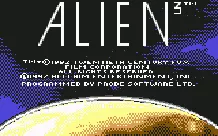Alien Legacy
Description official descriptions
After an alien attack in 2043, great technological leaps were made and space travel was significantly improved upon. In 2119, fearing extinction, Earth built gigantic seedships designed as "arks" to propel people and the sum of human knowledge across the stars. One of these seedships, the UNS Calypso, is sent to Beta Caeli star system which is the farthest colony attempted yet. In 2135, a second seedship, the UNS Tantalus, is dispatched to the same destination in order to better the chances of human survival. The Tantalus is equipped with a more advanced fusion engine and thus will reach Beta Caeli some 21 years ahead of the Calypso. The player takes the role of the Calypso's captain. There is no sign of the Tantalus. All you have are some 5000 colonists, past radio transmissions and a few key advisers to help you colonize this new unfamiliar solar system.
The game has three distinctive parts: global strategy, colony management and searching planets. The latter is always the first part before colonizing a planet: Every planet is divided into sectors which can be chosen on a world map. Then the game switches to a 3D view (which can be switched to a 2D view) in which the player explores the sectors in search of different symbols - clicking on them results in certain benefits. Examples are ore and energy, the two main resources in Alien Legacy, new life forms or traces of a lost civilization which give hints about the awful events of the past. With the correct technology the player can scan both the world map and the sectors to shorten the search - but this costs fuel.
The strategy mostly involves sending out ships to new planets to colonize and researching. Research is powered by "research points" in different categories, e.g. biology or math, which are gathered when searching sectors. By using those points the player gets different technologies of various use like more productive mines or a better range for space ships. Lastly the colonies are viewed from a top-down perspective. Here the player constructs up to 16 buildings to produce resources or space ships. Those buildings have to be maintained or can be upgraded/replaced with the newest research achievements. Every colony also needs a steady number of people, material and robots or it can't produce.
The game is played in real-time; the rounds (two rounds represent a month) elapse if the player is active or not. But time can be slowed down to ease the stress. After about 2000 rounds the peaceful colonizing is over, and the player has to fight a war against an unknown foe..
Groups +
Screenshots
Promos
Videos
Add Trailer or Gameplay Video +1 point
See any errors or missing info for this game?
You can submit a correction, contribute trivia, add to a game group, add a related site or alternate title.
Credits (DOS version)
59 People (53 developers, 6 thanks) · View all
| Producer | |
| Team Leader | |
| Art Director | |
| Design | |
| Programming | |
| Audio Engineering | |
| Music / Sound | |
| Art and Animation | |
| Test Manager | |
| Lead Tester | |
| Playtesters | |
| [ full credits ] | |
Reviews
Critics
Average score: 79% (based on 14 ratings)
Players
Average score: 3.8 out of 5 (based on 28 ratings with 3 reviews)
A game that toyed with greatness, but was gutted by bugs.
The Good
Despite its many and numerous flaws, Alien Legacy managed to accomplish something that few other games have ever accomplished for me in nearly 20 years of computer gaming. It made me feel like I really was colonizing wildly disparate environments in a solar system light years from Earth. It had an immersiveness for me that no other game in the "colonize remote planets" genre has provided. That alone made it memorable.
The Bad
Sadly, Alien Legacy was rife with bugs. And not just minor bugs, either. We're talking major show-stopping, game-killing bugs. The biggest one of the bunch was the fact that time was supposed to stop during certain phases of the game, but it didn't. This was crucial because the game was essentially an adventure game draped in the garb of a space colonizing sim, and many of the plot devices (how soon the aliens started attacking you, how long you had to peacefully noodle around in space before dropping your first colony, etc) were triggered by the timer. The aliens would always start attacking on day X, your crew would always mutiny on day Y, etc.
This wouldn't have been a problem, except that a lot of the gameplay involved piloting your ship over the surfaces of the planets in your new solar system looking for resources. When you were in this particular phase, the game timer was supposed to stop, so that when you finished flying over the planet, you wouldn't have lost any time in the macro game. But it didn't stop. So while you were flying around the planets looking for resources, the game timer was ticking away, meaning that when certain game plot elements were triggered, you wouldn't be prepared for them.
Damned annoying.
The Bottom Line
It could have been really great, but it wasn't.
DOS · by Afterburner (486) · 2001
A great story of a little seedship... well, at least if you have the CDROM version
The Good
Let me get this out of the way... the CDROM version fixes many if not most of the bugs that plagued the disk version and made it frustrating for players. While I'm on the subject, the CDROM version also adds voices for each of your advisors.
Ahem. Okay. Got that? Good.
Now, this game sends your seedship, the UNS Calypso out on a perilious mission to the stars. Although you are supposed to meet another seedship, the Tauntalus in the system already, and hopefully colonizing the system... something instead has gone horribly wrong. You start the game with one big seedship, one planet sized base, 5 shuttlecraft and 5 advisors to bring important things to your attention. The game is a hybrid. The main game is a strategy game where you build up your bases, research technology and collect resources... but seemlessly intergrated with that is a pseudo-flight sim that allows you to fly around the planet, seperated into landscape sectors to explore and find more resources. In fact you can litterally just spend hours checking every single sector of any given planet for ore, energy or interesting artifacts. And once you get the artifact detector, it's difficult to resist that urge.
The game is played in turns, however the game clock stops whenever any of these 'flight' sequences occur. Additionally all the bodies in the system rotate around the sun, so what may be close a couple of turns ago can quickly get far away.
As you grow you'll discover artifacts and clues pertaining to the fate of the Tauntalus and the plot will grow. Between asteroids, moons and planets, there's over 30 bodies that you can land on and explore and possibly colonize. And additionally you can build a space station around almost any of them. That's a lot of destinations to get to
The Bad
It's hard. It's hard and most of the time when you're attending to duties, the clock is marching away (as it should)... meaning that things can happen fast and it's easy to make mistakes in later parts of the game. Still, it pauses in all the important parts... during Exploration and while you're trying to read data on your PDA.... but still, it's very easy to be finetuning a shuttle mission over several turns.
The game manual is full of two fulled pages of dossiers for each of your advisors. Date of birth, history, military rank, previous history, dossier. So imagine my disappointment when I discovered that upon starting a new game... your advisors are randomly determined from the pool for their position. It's not a major issue (there are only 2 advisors for each of 4 positions... you'll either get one or the other), however I'm used to the highest ranking officers on the bridge ;). Along the same issue, each of the characters have digital voices... but must act off the same scripts. Because of this, the DEPARTMENTS develop personalities... but not the advisors themselves. But at least there's some emotion in the voices :)
Also, two of the required science resources, MATH and PHYSICS are very rare when compared to all of the other types. Considering how many research projects need a decent ammount of MATH or PHYSICS knowledge... it's not uncommon to be stuck, unable to do any resource because you're waiting for the slow research labs to produce some more of these over 20 or 30 turns.
Finally the colony overview screen is a mess. At least it is if you have any decent number of colonies. Only 3 are displayed on the screen at one time, which ammounts to a lot of scrolling, or a lot of clicking different colonies. Along the same problem... the destination list for shuttle missions fills up very quickly and gets messy. There's no method to reorder either of these lists. Colonies are displayed in the order they have been created.
The Bottom Line
Survivalist. You're a lone mothership. You need to find good deposits of resources. You need to find out what happened to the other mothership. And you need to start colonizing this solar system. There's no time to waste and no backup plan should things start to go wrong.
I love this game and I love its atmosphere. It's very easily one of my favorites. However even on the CDROM version, the interface remains messy and you'll be cursing over that before you'll ever come across anything hostile you can turn your aggressions to.
DOS · by Shoddyan (15003) · 2003
A combination resource management and adventure game, that doesn't quite work.
The Good
A massive storyline - deep, compelling and inventive. This game will eat away at your free time as you slowly come to grips with the story. What happened to the previous colonists? Why are we being attacked by belligerent plants? What the hell is going on?!
There's a need to juggle scientific advancement with political awareness. Build up your bases and military, but don't expand too quickly or your colonies will fall.
This is a big, big game, and it is pretty original. I'm just not entirely sure it's worth it.
The Bad
The 'flight-sim' bit is truely horrible - the lousy graphics are merely painful, it just takes (literally) hours searching the area for energy and resources.
The game gets pretty repetetive after a while, and although there's this compelling storyline running alongside, you rarely get to interact with it. When you do, the clues lead you in a very linear path, with little chance for deviation.
The worst thing about this game is the fact that when I finally reached the grand finale, it crashed. Re-loading any of my several save games (I thought I was prepared) didn't work. Nothing worked. I was gutted. All that time and effort for nothing.
After a few months I tried the game again. Although I played it in a different way, the story came together the same. As with any adventure game, there is just one way to tell the story. Once you've seen it once, the game is never quite the same again. Anyway, I got to the grand finale again and it crashed again. I cursed its name and threw the disks away.
The Bottom Line
A deep, compelling storyline over a resource management game. It excels at neither aspects, and ultimately proves disappopinting.
DOS · by Steve Hall (329) · 2000
Discussion
| Subject | By | Date |
|---|---|---|
| Looking for an ico for Alien Legacy | Ken Garland | Mar 17, 2010 |
| Patch location? | J B | Apr 9, 2009 |
| Regular crash | Daniel Shaver | Nov 4, 2008 |
Analytics
Upgrade to MobyPro to view research rankings!
Identifiers +
Contribute
Are you familiar with this game? Help document and preserve this entry in video game history! If your contribution is approved, you will earn points and be credited as a contributor.
Contributors to this Entry
Game added by Ray Soderlund.
Additional contributors: Shoddyan.
Game added March 30, 2000. Last modified August 31, 2023.

